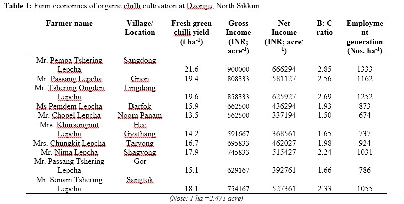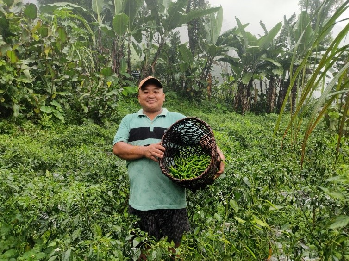In the lush Lepcha heartland of Dzongu, North Sikkim, farming has always been practiced in harmony with nature. The region, known for its traditional organic methods, faced a growing challenge in recent years declining crop yields and profitability. Heavy rainfall encouraged rampant weed growth, while carrying bulky organic manure across steep terrains made farming increasingly labor-intensive. As profits fell, younger generations began to drift away from agriculture, leaving many tribal households struggling to sustain their livelihoods.

A turning point came in 2021 when the ICAR–NEH Sikkim Centre, in collaboration with the Department of Horticulture, Government of Sikkim, introduced a technology demonstration programme under the Tribal Sub Plan (TSP). A total of 237 farmers from Lingdong-Barfok, Hee-Gyathang, Gnon-Sangdong, and Lum Gor Sangtok were selected for organic chilli cultivation trials. The initiative provided them with improved chilli varieties Arka Meghana (F1, tolerant to powdery mildew and mosaic virus) and Arka Sweta (virus tolerant) alongside mulching technology to suppress weeds and conserve soil moisture, foliar sprays of seaweed extract (IFFCO-Sagarika) to stimulate growth, and vermicompost application for soil health.

The results were transformative. Mulching reduced labor costs by curbing weed infestation, while seaweed sprays nearly doubled yields compared to traditional practices. Harvesting began in June and continued until October, with farmers picking chillies three to six times and selling them at ₹100–120 per kg in local markets. For Mr. Pempa Tshering Lepcha of Sangdong, the adoption of these practices resulted in a benefit-cost ratio of 2.85, while Mr. Tshering Ongden Lepcha of Lingdong achieved 2.69, setting inspiring examples for their communities. Better market access through Mangan ensured higher profits, though some villages near Dikchu faced challenges of fluctuating demand and weaker road connectivity.

Beyond higher incomes, the initiative sparked a cultural revival. The sight of flourishing chilli fields rekindled interest among rural youth, who began to view farming as a viable livelihood once again. Neighboring villages quickly adopted the model, leading to expanded cultivation areas and stronger community participation in organic farming. For the Lepcha farmers of Dzongu, chilli is no longer just a crop—it has become “red gold,” symbolizing resilience, prosperity, and the successful blend of tradition with modern agricultural technology. This success story demonstrates how sustainable innovations, when aligned with local wisdom, can secure livelihoods and transform the future of farming in the Sikkim Himalaya.
(Source: ICAR–NEH Sikkim Centre)








Like on Facebook
Subscribe on Youtube
Follow on X X
Like on instagram